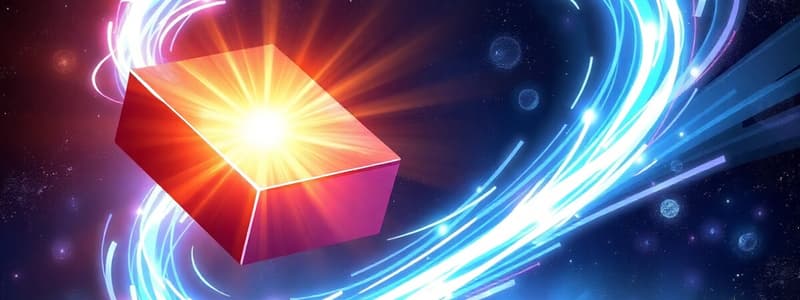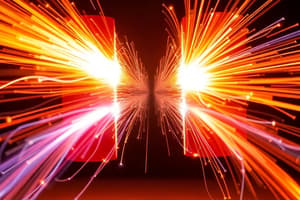Podcast
Questions and Answers
Why does a ball eventually stop rolling when rolled on the ground?
Why does a ball eventually stop rolling when rolled on the ground?
Friction between the ball and the ground causes it to slow down and stop.
Give an example, from the text, of how friction helps us in everyday life?
Give an example, from the text, of how friction helps us in everyday life?
Friction enables us to walk on the ground without slipping.
List two effects a force can have on an object.
List two effects a force can have on an object.
A force can start an object moving and/or it can change the shape of an object.
Name two devices that use magnets, according to the text.
Name two devices that use magnets, according to the text.
What is unique about an electromagnet, according to the text?
What is unique about an electromagnet, according to the text?
What is the historical origin of the term 'magnet'?
What is the historical origin of the term 'magnet'?
Name three materials that are attracted to magnets.
Name three materials that are attracted to magnets.
What are the two poles of a magnet called?
What are the two poles of a magnet called?
What happens when two north poles of a magnet are brought together?
What happens when two north poles of a magnet are brought together?
How is a force defined in physical terms?
How is a force defined in physical terms?
Describe what type of force is slowing down a moving object.
Describe what type of force is slowing down a moving object.
Are all metals attracted to a magnet? Give an example of a metal that is not attracted to a magnet.
Are all metals attracted to a magnet? Give an example of a metal that is not attracted to a magnet.
Where on a magnet is the magnetic force at its strongest?
Where on a magnet is the magnetic force at its strongest?
Flashcards
Friction
Friction
A force that opposes motion between two surfaces in contact.
Force
Force
A push or pull that can change an object's motion, shape, or direction.
Magnetic Force
Magnetic Force
A force that acts on objects at a distance without physical contact.
Electromagnet
Electromagnet
Signup and view all the flashcards
Motion
Motion
Signup and view all the flashcards
What is a magnet?
What is a magnet?
Signup and view all the flashcards
What are magnetic and non-magnetic materials?
What are magnetic and non-magnetic materials?
Signup and view all the flashcards
What are the poles of a magnet?
What are the poles of a magnet?
Signup and view all the flashcards
How do magnet poles interact?
How do magnet poles interact?
Signup and view all the flashcards
What is a force?
What is a force?
Signup and view all the flashcards
What is friction?
What is friction?
Signup and view all the flashcards
Study Notes
Magnets
- Magnets are specific stones or materials that interact with certain metals. They can be natural (like magnetite) or man-made (from iron or steel). Man-made magnets come in various shapes (e.g., U-shaped, horseshoe, bar, rod, ring, button).
Magnetic Interactions
- Magnets attract some objects (iron, nickel, cobalt, steel), called magnetic materials.
- Non-magnetic materials (gold, silver, aluminum, copper, wood, paper, plastic, glass, clay) are not attracted to magnets.
- Magnets exert a force on objects. This force is strongest at the poles (ends) of the magnet and weakest at the center.
Magnet Poles
- Magnets have two poles: North (N) and South (S).
- Like poles (N-N or S-S) repel each other.
- Unlike poles (N-S) attract each other.
Force
- Force is a push or pull. It causes changes in an object's motion or shape..
- Friction is a force that slows or stops motion.
Effects of Force
- Force can change an object's motion (start its movement, change speed or direction), shape, or size. It can also make a moving object stop.
Uses of Magnets
- Magnets are in many devices, including telephones, headphones, speakers, computers, and video recorders.
- Magnets help keep refrigerator doors shut.
- Electromagnets are temporary magnets activated by electric current.
Studying That Suits You
Use AI to generate personalized quizzes and flashcards to suit your learning preferences.



